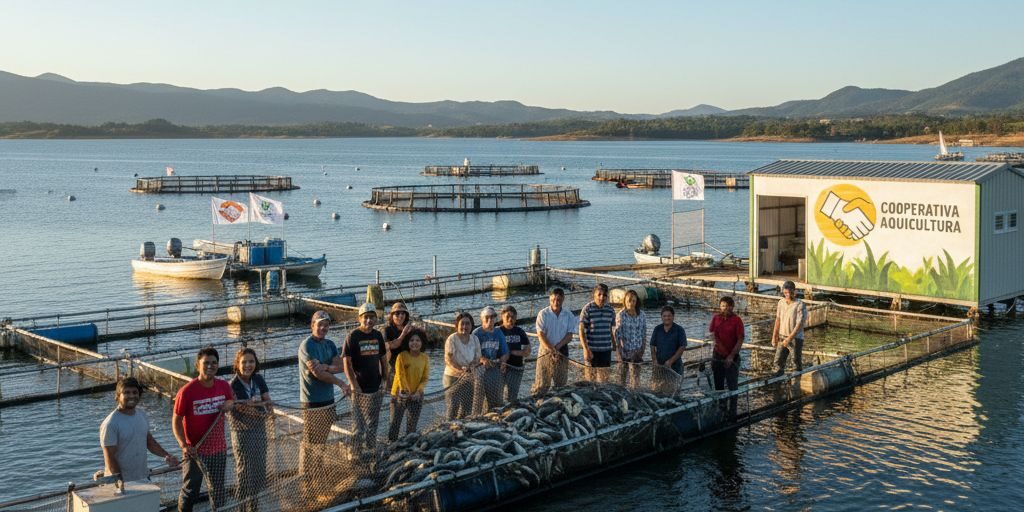- Software Gestor para Aquicultura
- (85) 2139-6730
- contato@despesca.com.br
Cooperativism in Aquaculture

Occupational Safety Standards in Brazilian Aquaculture
22/09/2025
How to Negotiate the Best Price at Harvest: Processors vs. Middlemen
24/09/2025Cooperativism in aquaculture represents one of the most effective strategies for the sustainable growth of small and medium-sized producers in Brazil. In an increasingly competitive market, individual challenges, such as low negotiation power and restricted access to larger markets, can be overcome through unity. Therefore, understanding the advantages of the cooperative model is essential for those seeking not only to survive but to thrive in the aquaculture business.
This business model is based on mutual collaboration, where producers organize to carry out operations together, sharing both costs and benefits. Thus, the cooperative acts as an entity that centralizes demands and offers, creating scale and, consequently, greater market power.
Greater Bargaining Power in Purchasing Inputs
One of the most immediate advantages of cooperativism is the large-scale purchase of inputs. Feed, post-larvae, fingerlings, and other essential production items see their prices significantly reduced when acquired in large volumes. A cooperative can negotiate directly with manufacturers, eliminating intermediaries and securing conditions that an individual producer would hardly achieve.
Furthermore, collective purchasing allows access to higher-quality inputs, which are often sold only in large batches. This directly impacts the health and development of the animals, resulting in a superior final product. The management of these purchases can also be optimized with tools that assist in cost and inventory control, ensuring transparency and efficiency for all cooperative members.
Accessing New Markets and Achieving Better Selling Prices
Just as in purchasing, the consolidated production volume of a cooperative opens doors to more demanding and lucrative markets. Large supermarket chains, restaurants, and especially the export market, require constant and large-volume supply. This is often a significant challenge for isolated producers. By uniting, aquaculturists in Brazil can meet this demand, negotiating more favorable contracts.
Consequently, the ability to negotiate selling prices also increases. The cooperative can regulate product supply in the market, preventing predatory competition among its own members and ensuring fairer remuneration for fish or shrimp.
Production Standardization and Quality Seals
The consumer market increasingly values the origin and quality of food. Cooperatives play a crucial role in standardizing cultivation methods among their members. This uniformity in the production process not only improves the overall quality of the product but also facilitates obtaining certifications and quality seals, such as sustainable production or good management practices.
These certifications add value to the final product and are often prerequisites for accessing premium markets. Standardization also simplifies the implementation of traceability systems, allowing the final consumer to know the entire journey of the product, from farm to table, thereby increasing trust in the cooperative’s brand.
Sharing Knowledge and Technology
The cooperative environment is extremely fertile for the exchange of experiences and technical knowledge. Challenges faced by one producer can be quickly resolved with the help of more experienced members. Additionally, the cooperative can invest in hiring specialized consultants, such as fisheries engineers and zootechnicians, whose costs are shared among all, making high-level technical assistance accessible.
The acquisition of modern technologies, such as more efficient aeration systems, water parameter monitoring equipment, and management software, also becomes more viable. A platform like Despesca, for example, when adopted by the cooperative, allows all members to use the same methodology for recording production data, facilitating comparative performance analysis and identifying bottlenecks and improvement opportunities for the group.
In summary, cooperativism in aquaculture is a strategic path to strengthen the sector in Brazil. It transforms individual producers into a cohesive and competitive block, capable of negotiating better conditions, accessing new markets, and promoting the technological and sustainable development of their farms.

